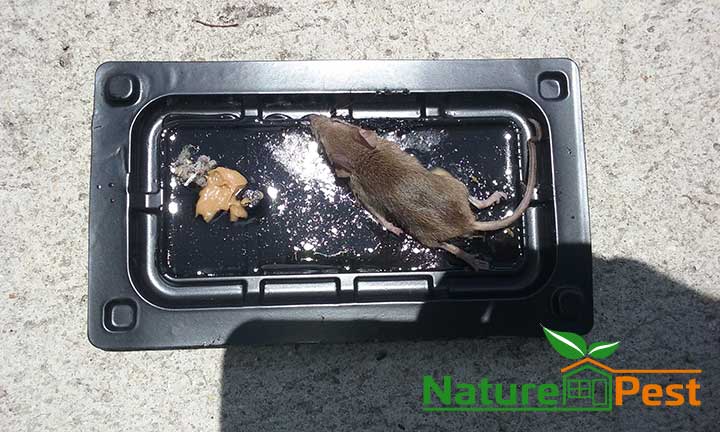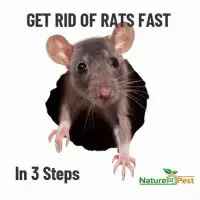Get rid of rats in house fast by Following These 3 Steps
Rats are a common household problem that can cause significant damage to your property and pose health risks get rid of rats fast to prevent damage and disease. Getting rid of rats quickly is crucial to maintaining a clean and safe living environment. In this guide, we will outline 3 simple steps to help you get rid of rats from your home fast and effectively.
1 Inspection, Identification & Assessment
2 Trapping
3 Exclusion & Sanitation
CAUTION: Handling Dead Rodents Safely: The Importance of Wearing Personal Protective Equipment (PPE)
Handling dead rodents can pose significant health risks due to the potential for disease transmission. Rodents are known carriers of various pathogens that can cause serious illnesses in humans, such as hantavirus, leptospirosis, and salmonellosis. To protect yourself and others from these dangers, it is crucial to wear appropriate personal protective equipment (PPE) when handling dead rodents. Here are some reasons why wearing PPE is essential:
Prevention of Direct Contact: Wearing gloves, such as disposable latex or nitrile gloves, prevents direct contact with the dead rodent and any contaminants it may carry. This significantly reduces the risk of contracting diseases from handling infected rodents.
Protection from Airborne Pathogens: Some diseases, like hantavirus, can be transmitted through airborne particles released when handling contaminated rodent carcasses or nesting materials. Wearing a mask or respirator, preferably an N95 or higher, can help protect you from inhaling these hazardous particles.
Minimizing the Spread of Contamination: Wearing disposable PPE, such as coveralls or aprons, can prevent contamination of your clothing and minimize the spread of pathogens to other areas of your home or workplace.
Eye Protection: Wearing safety goggles or glasses can protect your eyes from any splashes, dust, or debris that may be released while handling dead rodents, reducing the risk of infection through the eyes.
Safe Disposal: After handling dead rodents, it’s important to dispose of used PPE properly, preferably in a sealed plastic bag or biohazard container. This helps contain any potential contaminants and prevents the further spread of diseases.
Disease Transmission By Rodents
Rodents can spread a variety of diseases to humans so its important to get rid of rats quickly, either directly or indirectly. Direct transmission occurs through contact with rodent feces, urine, or saliva, or through bites. Some of the diseases directly transmitted by rodents include:
Hantavirus Pulmonary Syndrome
Leptospirosis
Lymphocytic Chorio-meningitis (LCM)
Indirect transmission occurs when humans come into contact with fleas, ticks, or mites that have previously fed on an infected rodent. Diseases that can be indirectly transmitted by rodents include:
Plague
Lyme Disease
Rickettsialpox
Ectoparasites
Ectoparasites Transmitted By Rodents
In addition to carrying diseases themselves, rodents can also introduce ectoparasites such as fleas, ticks, and mites into your home. These parasites can infest your living spaces and pets, causing discomfort, irritation, and potentially spreading diseases to you and your family. Some of the most common ectoparasites associated with rodents include:
Rat fleas (Xenopsylla cheopis), which can transmit the plague
Deer ticks (Ixodes scapularis), which can transmit Lyme Disease
Mites, which can cause allergies and skin irritation in humans and pets
Step 1: Inspect, Identify Rodent Species and Asses Entry Points and Hotspot.
Rodent Proofing is Rodent Control The first step to get rid of rats is to identify and seal any potential entry points. Rats can squeeze through small gaps and holes as small as half an inch in diameter. Inspect your home thoroughly, paying close attention to areas around pipes, vents, and eaves. Use steel wool, caulk, or metal sheeting to seal any openings you find. This will prevent new rats from entering your home and help contain the existing infestation.
“An ounce of prevention is worth a pound of cure” is a well-known proverb that emphasizes the importance of taking preventative measures to avoid problems, rather than dealing with the consequences later. The idea behind this saying is that it is often easier, less costly, and more effective to prevent problems from occurring in the first place, rather than trying to resolve them after they have already happened.
This proverb can be applied to various aspects of life, including health, safety, maintenance, and relationships. For instance, in the context of rodent-proofing a home, taking proactive measures like sealing entry points, keeping the house clean, and storing food in sealed containers can prevent rodent infestations. Addressing these issues before they become a problem can save homeowners time, money, and stress in comparison to dealing with a full-blown infestation and the damage it may cause.
Once rodents such as rats or mice make their way into your home, they bring with them a host of potential health risks. These pests can carry and transmit diseases through their feces, urine, and saliva, as well as through the ectoparasites—such as fleas and ticks—that live on their bodies. In this article, we will discuss the dangers associated with rodent infestations and the importance of timely and effective rodent control. Get rid of rats and get rid of health risks.
Get rid of rats fast Using Traps
Once you have sealed off entry points, it’s time to set up traps and bait to catch the rats that are already inside your home. There are various types of traps available, including snap traps, glue traps, and live-catch traps. Choose the trap that best suits your preferences and the severity of the infestation. Place traps along the walls, behind furniture, and in areas where you have noticed rat droppings or other signs of activity. Use bait such as peanut butter, cheese, or fruit to lure rats into the traps. Check and replace traps regularly until you have caught all the rats.
I Cant get rid of rats, I have put out traps and glue boards and I’m not catching any rodents, Why?
Common Mistakes and How to Avoid Them
Using snap traps can be an effective way to get rid of rats and reduce rat populations on your property. However, sometimes these traps may not yield the desired results, leaving you frustrated and wondering what went wrong. In this article, we will explore some common reasons for snap trap failure, such as failing to assess hot spots, placing traps in incorrect locations, incorrect trap placement direction, using the wrong food attractant, and competition from other food sources.
Failing to Assess Hot Spots
One reason for snap trap failure could be neglecting to identify and assess the hot spots where rats are most active. Rats tend to follow specific paths and concentrate their activity in certain areas. To increase your chances of trapping success, it is crucial to locate these hot spots and place your snap traps accordingly. Inspect your property for signs of rat activity, such as droppings, gnaw marks, or burrows, to identify these high-traffic areas.
Rodent Neophobia
Rats are exploratory; however, at the same time, they are naturally neophobic (the fear and avoidance of new objects). Neophobia is a survival mechanism to protect from the new and unknown and often occurs when rats are presented with freshly placed rodenticide bait or bait box or monitoring devices.
Avoid Moving Traps Based on Sightings: Stick to the Initial Assessment for Effective Rodent Control
Resist the urge to move traps around the house based on recent rodent sightings. Stick to the initial assessment to avoid triggering neophobia, which makes rodents shy and cautious. For successful rodent control, it’s essential to maintain a strategic and consistent trap placement, rather than constantly changing locations in response to sightings. Trust the assessment and give the traps time to work effectively. Additionally, regularly moving traps can disrupt the scent trails that rodents leave behind, which are often used to navigate their surroundings. If you have a mice problem, patience and persistence are key to achieving long-term results. Stick to the original plan, monitor the traps, and make adjustments only if there’s clear evidence that the current setup isn’t working.
Placing Traps in the Incorrect Location
Even if you have identified the hot spots, placing traps in the wrong location within these areas can lead to failure. Rats are cautious creatures and may avoid traps placed in open or exposed locations. To maximize your chances of catching rats, place snap traps along walls, in dark corners, or near burrow openings, where rats are more likely to encounter them.
Incorrect Rat Trap Placement Direction
The direction in which snap traps are placed can also impact their effectiveness. Rats typically run along walls and edges, using their whiskers to guide them. To increase the likelihood of capturing rats, place snap traps with the baited end facing the wall. This positioning ensures that rats will encounter the baited end first as they travel along their usual paths.
Using the Wrong Food Attractant
The choice of bait can also influence the success of your snap traps. Rats have preferences for certain types of food and may not be attracted to the bait you are using. Some common bait options include peanut butter, bacon, and chocolate. Experiment with different bait types to determine which works best for the rat species in your area. Additionally, avoid using too much bait, as this can make it easier for rats to steal the bait without triggering the trap.
Rat Has Access to Other Food Sources
If rats have access to other food sources, such as pet food or unsecured garbage, they may be less inclined to take the bait on your snap traps. To increase the effectiveness of your traps, eliminate competing food sources by storing pet food in airtight containers, securing garbage cans, and maintaining cleanliness in your property.
The Use of Live Active Traps for Humane Rodent Control and the Importance of Exclusion and Pest Proofing
Live active traps are an effective and humane way to get rid of rats in your home. These traps are designed to capture rodents without causing them harm, allowing for a more compassionate approach to pest control. However, if you plan to release trapped rats back into the environment, it’s crucial to ensure that your home has undergone proper exclusion and pest-proofing measures. Otherwise, you may find yourself in a vicious cycle of rats returning and re-infesting your property.
Exclusion and pest-proofing are essential steps in rodent control to get rid of rats permanently, which involve sealing off any potential entry points for rats. This may include fixing gaps, cracks, and holes in walls, doors, windows, and other access points. In addition, installing door sweeps, repairing damaged screens, and using metal mesh to cover vents can help prevent rats from finding their way back into your home.
When using live active traps, it’s important to remember that releasing rats back into the environment must be done responsibly. Rats have a strong homing instinct and can travel long distances to return to their original nesting site. Releasing them too close to your home may result in the rats finding their way back inside, leading to a continuous cycle of re-infestation.
To break this cycle and ensure effective, long-term rodent control, follow these steps:
Perform a thorough exclusion and pest-proofing service on your home, sealing off all possible entry points.
Set up live active traps in strategic locations where rat activity has been observed, such as near food sources and nesting sites.
Monitor the traps regularly and promptly remove any captured rats.
Release the rats in a location far enough from your home to minimize the chances of them returning. Consult local guidelines or professional pest control services for advice on appropriate release locations.
Continue to maintain exclusion and pest proofing measures to protect your home from future infestations.
By combining the use of live active traps with proper exclusion and pest proofing, you can humanely and effectively control rat populations in your home. This approach not only helps break the cycle of re-infestation but also promotes a safer and healthier living environment.
The Inhumane Nature of Glue Boards for Trapping Rats and the Potential for Escaped Rodents
 Glue boards are a controversial method for trapping rats due to their inhumane nature and the potential for prolonged suffering. While they may seem like a convenient option for rodent control, the use of glue boards is strongly discouraged by animal welfare organizations due to the distress and pain they cause to trapped animals.
Glue boards are a controversial method for trapping rats due to their inhumane nature and the potential for prolonged suffering. While they may seem like a convenient option for rodent control, the use of glue boards is strongly discouraged by animal welfare organizations due to the distress and pain they cause to trapped animals.
When rats become stuck on a glue board, they often struggle for hours or even days in an attempt to free themselves. This can result in severe injury, dehydration, and exhaustion. In some cases, rats may even attempt to chew off their own limbs to escape the adhesive trap. The suffering endured by these animals is not only unethical but can also lead to further complications in rodent control efforts.
One such complication is the possibility of adult rats escaping the glue board. While a rat may initially become trapped, it can sometimes manage to break free, leaving the glue board behind. This not only renders the trap ineffective but can also make it more difficult to catch the rat in the future. Having experienced the distress of being caught on a glue board, the rat is likely to become wary of similar traps, making future attempts to capture it significantly more challenging.
Given the inhumane nature of glue boards and the potential for escaped rats, it’s essential to consider more ethical and effective alternatives for rodent control. Some of these alternatives include:
Live active traps: These traps are designed to capture rats without causing them harm, allowing for a more compassionate approach to pest control. They can be placed in strategic locations where rat activity is observed and are often reusable.
Snap traps: Although lethal, snap traps provide a quicker and more humane death for rats compared to glue boards. Properly set snap traps can instantly kill rodents, minimizing suffering.
Preventative measures: Exclusion and pest proofing methods can be employed to prevent rats from entering your home in the first place. Sealing potential entry points, eliminating food sources, and maintaining a clean environment can all contribute to effective rodent control without the need for traps.
By choosing more humane and efficient methods for rodent control, you can protect your home from infestations while also promoting animal welfare and reducing unnecessary suffering.
Snap Traps for Rodent Control: Comparing Traditional Wood Traps and Modern Plastic Traps
Snap traps are a popular method for getting rid of rats, offering a relatively quick and efficient means of rodent control. However, there are differences between traditional wood snap traps and modern plastic snap traps that should be considered when choosing the best approach to rodent control in terms of both effectiveness and humaneness.
Traditional Wood Snap Traps:
These classic traps have been used for decades to catch and kill rats. They consist of a wooden base, a metal spring-loaded bar, and a trigger mechanism. When a rat steps on the trigger, the spring-loaded bar quickly snaps shut, killing the rodent instantly in most cases. The benefits of traditional wood snap traps include:
Affordability: Wood snap traps are generally inexpensive, making them a cost-effective solution for homeowners dealing with a rat infestation.
Quick death: When properly set, these traps often deliver a swift, lethal blow, minimizing the suffering of the trapped rat.
Modern Plastic Snap Traps:
Plastic snap traps are a more recent innovation in rodent control, designed with convenience and ease of use in mind. These traps feature a similar spring-loaded mechanism, but they are made of plastic and often include a quick-release feature. Some of the advantages of modern plastic snap traps include:
Easy disposal: The quick-release feature allows users to dispose of the dead rat without having to touch it, reducing the risk of disease transmission and making the process more hygienic.
Reusability: Plastic snap traps are often more durable than their wooden counterparts and can be easily cleaned and reused multiple times.
However, one notable concern with some plastic snap traps is that they may kill rats by strangulation rather than delivering an instant, lethal blow. This can result in prolonged suffering for the trapped rat, which may be considered inhumane.
In conclusion, both traditional wood snap traps and modern plastic snap traps offer advantages and disadvantages when it comes to rodent control. When selecting the best option for your situation, it is crucial to consider factors such as effectiveness, cost, ease of use, and humaneness. If the potential for inhumane deaths with some plastic snap traps is a concern, it may be worth seeking out alternative designs or using traditional wood snap traps to ensure a quick and humane death for the trapped rodents.
The Goodnature A24 Home Outdoor Kit: A Humane and Pet-Friendly Solution for Rat and Mouse Control
The Goodnature A24 Home Outdoor Kit is a cutting-edge, humane solution for dealing with rat and mouse infestations. Designed with the well-being of both rodents and non-target animals in mind, this innovative trapping system offers an effective and environmentally friendly approach to get rid of rats. The kit includes a digital strike counter, tree mount, automatic paste pump, and a CO2 canister, making it an all-in-one solution for homeowners seeking a humane and pet-friendly option.
Key Features of the Goodnature A24 Home Outdoor Kit:
Humane Rat and Mouse Trap: The A24 trap uses a CO2-powered piston to deliver a quick, lethal blow to rodents, ensuring a humane death with minimal suffering. This method is considered more humane than traditional snap traps or glue boards, which may result in prolonged suffering for trapped rodents.
Digital Strike Counter: The digital strike counter included with the kit allows homeowners to monitor the effectiveness of their trap, providing valuable information on the number of rodents killed. This can help users optimize trap placement and assess the overall success of their rodent control efforts.
Tree Mount: The tree mount included in the kit enables users to securely attach the A24 trap to trees, fences, or other vertical surfaces, ensuring the trap remains stable and effective. This makes it easy to place the trap in strategic locations where rodent activity is observed.
Automatic Paste Pump: The automatic paste pump dispenses a specially-formulated, long-lasting bait that attracts rats and mice to the trap. The paste is designed to be highly appealing to rodents, increasing the likelihood of a successful catch.
CO2 Canister: The CO2 canister powers the trap’s piston, enabling it to deliver a quick, lethal blow to rodents. Each canister is capable of providing enough power for up to 24 strikes, reducing the need for frequent maintenance and making the trap more convenient for homeowners.
Pet-Friendly: The A24 trap is designed to be pet-friendly, minimizing the risk of accidental harm to non-target animals. The trap’s mechanism is only activated when a rodent enters the trap, reducing the likelihood of pets or other animals coming into contact with the device.
The Goodnature A24 Home Outdoor Kit is a humane, effective, and environmentally friendly solution to get rod of rats and mouse infestations. Although it comes with a higher price tag of around $200, the numerous benefits and features it offers make it a worthwhile investment for homeowners looking to address rodent problems without compromising on quality or ethics.
In conclusion, rodents pose significant health risks to humans through the transmission of various diseases. It is crucial to employ comprehensive rodent control strategies, including sanitation, rodent exclusion, pest proofing, and humane trapping methods. Additionally, it is important to be aware of the dangers associated with handling dead rodents and to use proper personal protective equipment when doing so.
Don’t wait until the rodent problem becomes unmanageable to get rid of rats. Act now to protect your home, family, and community from the risks posed by rodents. Contact a professional pest control service today to ensure the complete elimination of rodent populations and to create a safer, cleaner environment for everyone. Remember, prevention is always better than cure.



